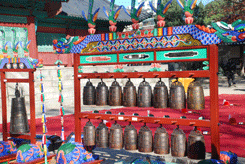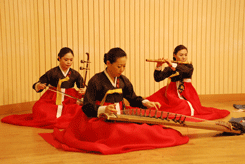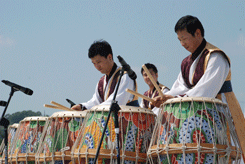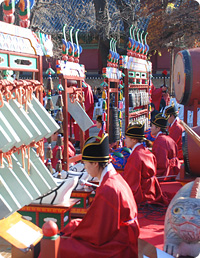Music
 |
 |
 |
Daegeum
It is the largest and most representative transverse flute of Korea. It has a blowing hole, a hole covered with a thin membrane, six finger holes and five making 13 holes in all. The vibration of the membrane gives a beautiful and expressive tone quality.
Piri
A Korean oboe that has long and double reed, and eight finger holes including the back hole, is the lead instrument which always plays the main melody in the Korean court music or folk ensemble. The sound is loud and has a distinctive of tone quality and timbre.
Haegeum
This two-stringed fiddle without a fingerboard is played vertically with a bow and is left on the left knee. The tone quality is markedly nasal and the sound is remarkably penetrating. The instrument is always found in Korea court chamber and folk musical ensembles.
Gayageum
It was first created in the 6th century by Gasil. Gayageum is a traditional Korean zither with twelve silk strings supported by 12 movable bridges. The thumb, index finger and middle finger of the right hand pluck the strings while index and middle fingers of the left hand touch the string on the left side of the movable bridge. The tone quality of Gayageum is clear and delicate. A Popgum, a smaller and narrower Gayageum which is remodeled for a Sanjo Gayageum, is used for fast fingering of folk music and Sanjo music.
Geomungo
The Geomungo is representative of zithers which have six strings of twisted silk. The second, third, and fourth strings are stretched over 16 fixed frets and tuned by round pegs, while the rest of the strings are stretched over movable bridges and tuned by moving the bridges to the left or right. The strings are plucked with a bamboo rod which is held between the index and middle fingers of the right hand, while the left hand presses on the strings to produce microtones.
Dangjeok
The Dangjeok is the smallest transverse flute. It is similar to the piccolo of the West. The tone quality is pure and clear, particularly in the upper register. It is only played together with Daegeum.
Janggo
The hourglass drum is the most frequently used accompaniment to almost all kinds of Korean music. The thick skin of the left side is struck with the palm, making soft and low sound, and the thin skin of the right side is stuck with a bamboo stick, giving a hard sound. The right side can be tuned higher or lower by moving the central belts encircling the V-shaped laces to the right or to the left, thus tightening or loosening the tension of the drum head.
Nagak
The conch shell trumpet, producing only one deep note, is use exclusively as a drone in the military processional band in alternation with the Nabal, a long trumpet.
Taepyeongso
Literally meaning Great Peace Flute is a conical wooden oboe with eight finger holes, a metal mouthpiece, and a cup-shaped metal bell. It produces a very loud and piercing sound and is used for traditional band music for farmers, the military and folklore.
Ajaeng
The Ajaeng is bowed seven-stringed zither, played with a wooden bow, rosined but without hairs. It was originally used in Chinese music but later adapted to the Korean musical ensemble. The melody of this instrument is always identical with 1/2 that of the two-stringed fiddle. Its loud tone reinforces that of the Haegeum.
Nabal
It is the only Korean metal trumpet. It is without finger holes, and is used to produce only one sustained tone. It is now played exclusively in military processional bands to sound a one-note drone in alternation with the conch shell trumpet.
Danso
The Danso is a small notched, vertical bamboo flute with five finger holes, one of which is on the back. The tone quality is exceedingly pure and delicate, making it a favorite solo instrument.
Bak
It is a clapper shaped like a folded fan. It consists of six pieces of wood loosely held together at the upper end by a cord made of deer skin. The pieces of wood are thicker at the loose ends. The Park is clapped once to start a piece of music and three times rapidly to mark the end of the piece. It is used by court and ritual orchestras.
Pyeonjong
it is a set of 16 bronze bell chimes hung in an elaborately decorated frame. The bells are all the same size and shape but the thickness of the walls is different which gives each a different pitch. The player sits behind the instrument on the ground and uses a mallet to strike the belts.
Pyeongyeong
The Pyeongyeong is a set of 16 L-shaped slabs of jade stone. The counterpart of the bell-chimes has played an essential role in court ceremonies since the 12th century. The stone slabs are the same size and shape, but they vary in thickness as that each has a different pitch. The thickest one produces the highest pitch while the thinnest, the lowest.
Chago
The Chwago is a medium size barrel drum hung from a frame. Its sound reinforces the hourglass drum. It is used mainly in court music to accompany wind ensembles or full orchestras
Kkweonggwari
It is a small flat gong used primarily in folk music of Korea. It is made of brass and is played with a hard stick, producing a distinctively high-pitched, metallic tone that breaks into a cymbal-like crashing timbre when struck forcefully. In farmer's band music, it is played by the leader to signal the other musicians of rhythmic patterns with a very sharp attention-commending sound.






